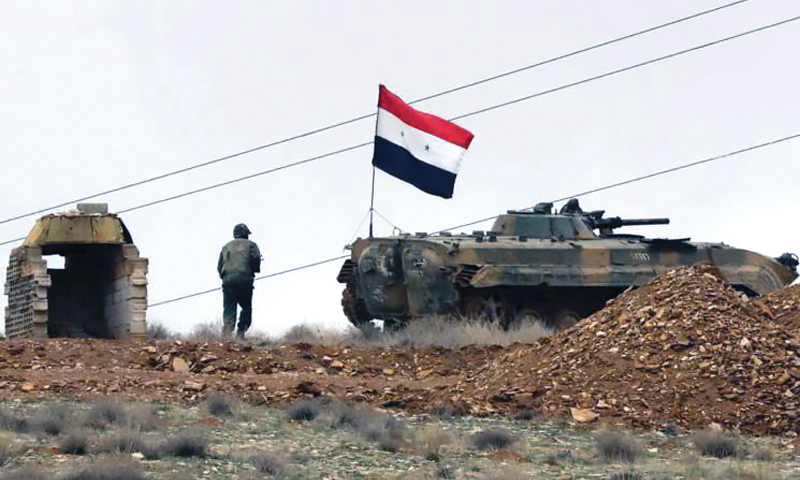
Four Provinces Affected by Russian Intervention in Syria

In the shadow of opposition retreat, four provinces affected by Russian intervention, changes in the war map
The military map in Syria has seen significant changes in the past five months since the beginning of Russian intervention into the country. Most of these changes have fallen in the regime’s favor, especially in four main provinces which are still embroiled in fierce clashes.
Opposition control has been waning. Aleppo, Latakia and Dara’a had been their areas, but Russian air raids have played a prominent role in tipping the balance of power, while the forces of the “third power” attempt to expel ISIS from the areas of its influence in Hasaka province, this time with the support of Washington and Moscow.
However, the Syrian regime has not succeeded in suppressing opposition groups in other provinces, despite Russian support, and Assad’s forces failed to realize any significant gains on the ground during the battles of Homs and Hama, in addition to other areas surrounding Damascus.
On September 30th, 2015, the Russian Federal Council, under the administration of Vladimir Putin, authorized the use of military air power abroad, including in Syria. Russian jets then began air raids all over Syria.
The official Facebook page of “The Presidency of the Syrian Arab Republic” published a statement saying, “sending the Russian Air Force into Syria came at the request of the Syrian state, through a letter sent by President al-Assad to President Putin. The letter included an invitation to the Russian Air Forces under President Putin’s initiative to combat terrorism.”
Aleppo knot and the four-sided conflict
The province of Aleppo has become the staging ground for the four principal powers: the Syrian regime and its allies from foreign and local militias in conjunction with Russian air power; the “Syrian democratic” forces, including Kurdish, Turkmen, and Syriac groups, who receive American and Russian air support as well; and the forces of the opposition in all its forms (Islamic, the Free Syrian Army, etc); and finally, ISIS (Daesh), which is considered an enemy by each of the other three groups.
Before Russian Intervention
The Syrian regime presence had been confined to Aleppo province before Russian intervention, in a few positions in the rural Northeast of the province, especially the region of As-Safira up to the Khanaser road, considered the only supply point for Aleppo. Because of this, the regime has protected its presence in the Western neighborhoods of the city, remaining in a relatively stable situation for the past three years.
Moscow’s military entrance into Syria coincided with the announcement of the establishment of the “Syrian democratic” forces in October 2015. The Kurdish People’s Protection Units were considered instrumental in its formation. They have received both American and Russian backing, and its forces controlled, during that time, Afrin in Aleppo’s northwestern countryside, up to the city of Ain Al-Arab (Kobani), in the northeast. But the map has changed since then.
The Syrian opposition held the greatest weight in the South, West and North of the city center, along with maintaining control of the eastern neighborhoods, and it tightened its grip on the second most important land crossing to Turkey, a border safety point, which, along with “Bab Al-Hawa,” is the main lifeline for the cities in the North.
Meanwhile, ISIS has established itself as the trustee of east Aleppo province, and controlled most of its cities and villages, including Al-Bab, Jarabulus, Manbej, Moskina and Kwers, all the way to the northern hubs of Dabiq, Turkmen Barah and others, before losing large areas at the end of last year.
The Battles of the East and South
October of last year was considered “zero hour” for Assad’s forces in Aleppo province, where they began attacks on two main axes, in the south and east. A series of unexpected circumstances gave the regime an unexpected boost and helped Assad’s forces to arrive at Kweres in the East, and the international highway to the South.
During the battle of Aleppo, the Syrian regime relied on Russia and Iran, who protected it with continued air cover during all of its operations, while others provided it with hundreds of “mercenaries” from a dozen militias composed of fighters from five foreign and Arab countries (Afghanistan, Pakistan, Iran, Iraq and Lebanon).
In the inventory of battles occurring in the eastern countryside, Assad’s forces managed to break the siege at the Kweres military airport, and to control most of the towns and villages surrounding it, including the thermal station near the city of Al-Safira. The forces reached close to the city of Al-Bab, ISIS’s capital in Aleppo.
The battles fought by Assad’s forces in the East are not limited to those against ISIS. They have also clashed with enemies near the Euphrates basin, specifically in the Manbej area. There, the Syrian Democratic forces and others gained control in December of a strategic dam, located near a number of village. They were also able to reach the outskirts of Manbej, which was controlled by ISIS.
To the south, Assad’s forces had moved from two important axes, Tel Shughayb and ‘Asan, towards areas controlled by the opposition, and were able to gain control of a wide area during three months of fighting. Most notably, they gained control of Al-Wadihi, Al-Hader, Al-’Ays, Barneh, Zeytan and Khan Toman. Forces arrived up to the edge of the international highway, and South Aleppo is now almost entirely in the hands of the regime.
Four colors mix in the North
North Aleppo hasn’t been isolated from military operations, either, despite the Russian delay in the first months of their involvement. Data at the time showed that ISIS was preparing for a major battle using militias. The battle for the North began in February 2016 and brought about a complete change in the power dynamics there.
Assad’s forces were able to attack the north, separating opposition areas into two parts, after seizing control of several strategic towns and villages, most notably Tel Jabin, Dweir Al-Zaytoun, Ratyan, Hardetneen, Mayer and Musqan, among others. The forces reached the two towns of Nubul and Al-Zahra, after Assad’s forces had blocked their roads for three years. They achieved all of this with unprecedented Russian help.
At the same time, forces overtook the “Syrian democratic forces” opposition factions, North of Aleppo, and launched a massive offensive on areas near the border with Turkey. They achieved gains in important areas, including Tel Rifaat, Mennegh military airport, and around fifteen towns and villages, including Mare’a and Azaz, the last two opposition strongholds in the North, under siege by three powers (the regime, Syrian democratic forces, and ISIS).
Assad’s forces are seeking to launch a new offensive on the western countryside of Aleppo, and thus have cut all the supply routes under control of the opposition in the city center neighborhoods, and have laid siege to about a million people in these cities.
Military analysts believe that success of Assad’s forces in the western part of the countryside would enable them to penetrate the northern areas in the neighboring province of Idlib, particularly the Atma region, which includes camps for displaced Syrians, and to cross Bab Al-Hawa on the border with Turkey.
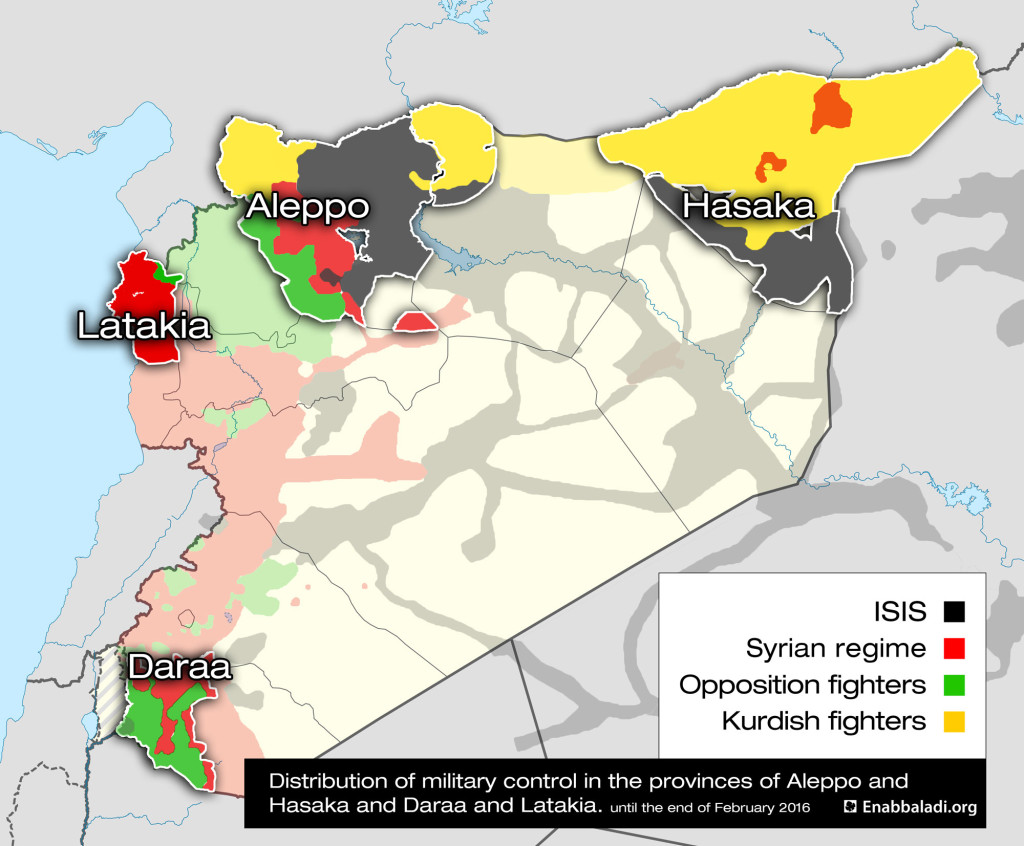
Hawran in Assad’s sights
Around 60% of Dara’a province is still under opposition control, (including by the Free Syrian Army and other Islamic groups such as Jabhat Al-Nusra, Harakat Al-Muthanna, and Ahrar Al-Sham), and the Yarmouk valley in the western countryside near the Golan Heights is under control of the “Martyrs of Yarmouk” brigade, which has sworn allegiance to ISIS.
During the past five years, the Syrian regime has neutralized a number of cities in conflict in the province. Al-Sanamayn, Azra’a, and Khorbat Ghazala have become the main centers of their forces there, along with about half the neighborhoods of the city of Dara’a, over which they maintain control. At the same time, the opposition has taken control over wide areas in the past few years, including the entire border with Jordan.
Daraa is significant as it lies near Damascus and the South Gate. This proximity helped the FSA’s progress there in 2014 and the first half of 2015 in closing the border crossing with Jordan after the FSA gained control in April of last year and paralyzed foreign trade to the Syrian regime. This badly damaged the regime economically, so it prepared all of its resources to begin a massive ground campaign under Russian auspices.
On December 25 of last year, Assad’s forces began a major military campaign against Al-Shaykh Miskin, in the northern countryside of Daraa, and succeeded in gaining control a month later after several battles and violent confrontations. Russian warplanes flew cover during the battles.
Atman, the northern gateway to the city of Deraa, had been under the control of the FSA for nearly three years. It was the second goal of Assad’s forces after Daraa. The battle was quick and over in a “flash”, as Assad’s forces imposed full control over the city in just three days. The battle began early February, and caused mass displacement of most of the population.
Assad’s forces didn’t stop after these two battles. They launched attacks inside the city of Daraa to regain control of several neighborhoods: al-Mansheya, Tariq al-Sad and al-Jamarek al-Qadim (Old Customs). This attack coincided with the imposition of a truce “by force” in the towns of Ebta’a and Da’el to the north. During this time, opposition forces were experiencing a period of weakness, exacerbated by internal fighting between the army and the Free Movement of the Islamic Muthanna.
Sheikh Miskin, a city 22 kilometers north of Daraa, is the fourth largest city in the province, after Daraa, Nawa and Al-Sanamayn. It had a population of about 50 thousand people before battles began raging there in 2014.
Sheikh Miskin forms a transport link for the three provinces (Damascus, Daraa, Al-Suwaida), as well as being the focal point between the cities of Nawa, Ezraa, Ebta’a, Da’el and Al-Sanamain, and is located in the middle of the Houran plain, making it an easy target for the FSA, which took control in December 2014. A year later it was retaken by the Syrian regime.
The Great Retreat in the Coastal Areas
Turkey, Russia and the Syrian regime have all intervened in northern Latakia province. Ankara has emphasized the necessity of opposition control in this province, to guarantee security on its southern border, and protect the Turkmen minority that inhabits the Turkmen mountains. Meanwhile, Moscow intends to enhance its military position in the plain, especially since Humaimam Airport has become one of its key airbases. Therefore, Assad has coordinated his targets with the Kremlin, including the Turkmen Mountains and Kurdish areas and the zones near Latakia and Tartous.
Opposition factions succeeded in retaining Turkmen areas in the north of Latakia for almost three years, and they controlled most of the towns and hills of the Kurdish and Turkmen mountains. The populations there experienced relative stability during that time, despite repeated intrusion attempts, most of which failed.
In October of last year, the Syrian regime and its allies began an assault on opposition areas in the Kurdish and Turkmen mountains from several directions, and managed within four months to make progress, for the first time. They gained control of strategic towns, the most important of which were Salma, Kinsaba, and al-Maroniat in the Kurdish mountains, and Rabia, Ghamam, and Zahia in the Turkmen mountains.
This left the Syrian opposition with only a few villages on the border with Turkey in Mount Turkmen, most notably Al-Yunisiyah, Zaytouna, and Shahrurah and Sellour, while Jabal Al-Akrad fell mostly under the control of the Syrian regime, along with the rural west of the opposition-held province of Idlib.
Turkey has failed to restrain Assad and his allies either on land or in the air, despite repeated promises by Turkish politicians to protect the Turkmen regions. The downing of a Russian warplane by a Turkish missile in November 2015 was a milestone in the battle of the plain, and it led to heightened tensions in the relationship between the two countries. Moscow increased the intensity of its air attacks on the area, causing the displacement of thousands of civilians towards the Turkish border.
“The Bayrbujaq area (Mount Turkmen), which is majority Turkmen, does not contain any ISIS supporters, let us not deceive each other… The Bayrbujaq area is populated by Turkmen, only, who are our brothers and our relatives .. They were being bombed by the Russians, who say they are bombing ‘Daesh’.”
-Recep Tayyip Erdogan, December 25, 2015
The Kurds Consolidate their Control in Hasaka
No less important than the three provinces mentioned above is Hasaka. Hasaka encompasses a wide area in northeast Syria and borders Turkey and Iraq, is multi-ethnic and religious, and has faced various cycles of clashes continuing to the present day.
Three major powers are concentrated in the province: the Syrian democratic forces, the Syrian regime, and ISIS. The first is a military arm of the autonomous administration which has controlled most of the northern areas there and, with the regime, divides the administration of the two cities of Hasaka and Al-Qamishli. The southern and eastern countryside of the province are under ISIS control, and the group tried to extend its control northward in 2014 and 2015.
And despite the fact that the Syrian democratic forces receive American support, they have also gained Russian acceptance since Moscow established itself in the country in October 2015. Moscow views them as a “moderate opposition” whose weapons are mainly aimed at the Islamic State in Hasaka, Raqqa and Aleppo. They have also faced the opposition in Northern Aleppo and have not confronted Assad’s forces or his militias; thus, they have been given the name “the third stream.”
Russian media outlets recently revealed they had landed helicopters and planes at the al-Qamishli civil airport, boosting the hypothesis of Syrian activists that the main faction of the “autonomous administration” receives military and logistical support from Moscow and the international coalition led by Washington.
In the beginning of November 2015, the same forces began an expanded ground offensive in the eastern countryside of Hasaka, with the town of al-Houl, occupied by the Islamic State, as the principal target, and were able to take formal control after about two weeks. They increased their presence there after seizing control of most of the surrounding villages with air support from the international coalition.
Calm gradually returned to the province after the battle of al-Houl. The the Syrian democratic forces declared a new campaign called “the wrath of Khabur” on February 16th in order to regain control over the city of Al-Shadadi (the center of Islamic State control in Hasaka) and were able to expel the organization after three days of battles. For the most part, the province of Hasaka has now come under autonomous administrative control and their military arm, except for some villages and sites adjacent to the province of Deir al-Zour in the south.
Shaddadi is located south of the city of Hasaka by about fifty kilometers, on the road between Mosul (the capital of the Islamic State in Iraq) and the provinces of Raqqa and Deir al-Zour, the sites of ISIS’s greatest influence in Syria. It sits on the banks of the Khabur River, one of the main tributaries to the Euphrates, and is the second most important area of Hasaka province in terms of oil production after Al-Ramilan, near Al-Malikiya.
The Syrian democratic forces announced their formation in October 2015. They are a coalition of Kurdish, Arab, Turkmen and Syriac factions led by the Syrian Democratic Council and headed by Haytham Mana’a.
The most prominent of its factions, the Kurdish People’s Protection Units, is the military arm of the Democratic Union led by Saleh Muslim. It has been accused by Turkey and the opposition coalition as being an extension of the PKK (which has been included in the list of terrorist groups by Turkey and the United States), along with the rebel army, the Syriac Military Council, and the forces of Al-Sanadid, “Burkan al-Furat”.
The most important gains the Syrian democratic forces have achieved in the first four months since their establishment have been al-Houl and Al-Shadadi in Hasaka in October, and Tal Rifa’at and the Mennegh airport in Aleppo.
There have been no credible indicators of a cease-fire or the initiation of a political settlement to end the continuous four-year march of war. Continuation of hostilities threatens other changes in the map of Syria. It seems the tide is turning in favor of the Syrian regime and its allies, as the opposition and its supporters are isolated and denied the implementation of promises of real support. The balance is shifting to where it was before Russian intervention, and the Assad regime, as well as the “third stream,” have been revived.
if you think the article contain wrong information or you have additional details Send Correction
-
Follow us :
Most viewed
- 311 casualties among government forces and civilians in Syrian coast
- Al-Sharaa and Abdi reach agreement on merger of SDF into Syrian state
- Syrian Defense Ministry appoints "Abu Amsha" as Hama Brigade commander
- Did Syrian state fall into coastal ambush?
- Rights organization documents government and civilian deaths in Syrian coast

















 A
A
A
A
A
A


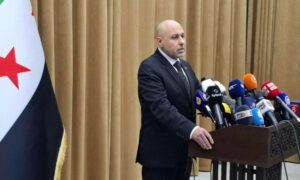
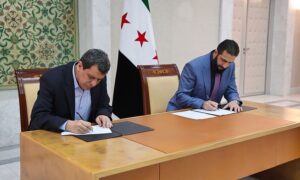
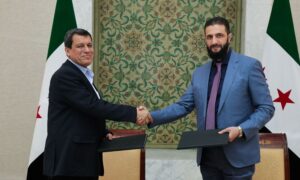
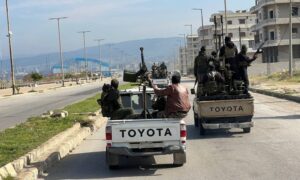
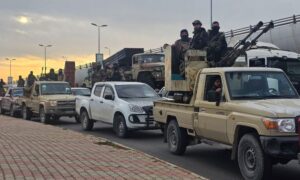
 More Politics
More Politics